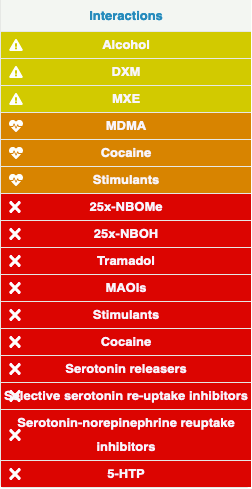[ Home ] [ Controlled Substances ] [ Stimulants ]
N-ETHYL MDA
|
MDEA works by releasing serotonin, a neurotransmitter that affects mood and perception. It requires a slightly larger dose (100 - 200 mg.) than MDMA with major effects lasting typically between three and five hours. The subjective effects of MDEA are similar to MDMA. The euphoric "loved up" feelings associated with MDMA use are not as pronounced. The effects are also not as stimulating as MDMA, MDEA has somewhat of a stoning effect and may be responsible for rumors of heroin-laced ecstasy pills. However, MDEA does have a mildly hallucinogenic effect. This, coupled with an increase in the user's energy levels (similar to amphetamine use) had led some users to conclude that MDEA is more suitable as a nightclub drug.
I went to a party and took a pill, that bean was pure MDE.
MDEA Interactions:
In the United States, MDEA was introduced recreationally in 1985 as a legal substitute to the newly banned MDMA before it was made a Schedule I substance two years later. Since then, MDEA has rarely been sold on its own and has largely been used as an occasional additive or substitute ingredient in pills of "Ecstasy". Very little data exists about the pharmacological properties, metabolism, and toxicity of MDEA. As a result it is highly advised to approach this potentially habit-forming entactogenic substance with the proper amount of precaution and harm reduction practices if choosing to use it.


https://psychonautwiki.org/wiki/MDEA
DOSAGE: 100 - 200 mg.
DURATION: 3 - 5 h.
QUALITATIVE COMMENTS:
(with 100 mg) There was a warm light all about me. And a gentle, almost alcohol-like, intoxication. The drug seems to change my state of awareness, but it does nothing else. The world is as intense or as dull as I choose to make it. At the 1.5 hour point I was clearly dropping, and an hour later yet, completely without residue.
(with 160 mg) The first effects were felt in forty minutes and I seemed to be completely there by the end of that first hour. There was an initial slightly dizzy intoxication, and then I felt very nice. A good intoxication, with maybe a little motor incoordination. There was absolutely no appetite at all. The next morning there was still some feeling of elation but I was still very relaxed. High marks for the quality of the experience.
(with 160 mg) Overall this was a wonderful experience. I felt that the effect was stronger and smoother than MDMA, but perhaps the group enhancement may be partly responsible. I felt definitely fewer physiological side-effects than with MDMA, particularly the urinating problem; although there was dehydration, there was less burning annoyance.
(with 160 mg) I was hard hit, to the extent that there was difficulty in verbalizing and following other people's thoughts. I entered the experience with some cold symptoms, and my sore throat disappeared. I felt quite intoxicated and tranquilized.
(with 200 mg) Very stoned. There was some nausea in the beginning of the experience. As it developed I found it very difficult to concentrate on what I was thinking or saying simply due to the extraordinary nature of coming on to this material. There is noticeable jaw-clenching and rice crispies in the ears. This is a meditative material not unlike MDMA except there are more difficulties in forming words. And there is a problem in focusing the eyes, what I want to call `eye-romp.' My anorexia was extremely long-lived - perhaps a total of 72 hours. This may have been too high a dosage.
Pharmacology:
MDEA has been shown to act as a releasing agent and reuptake inhibitor of the key monoamine neurotransmitters serotonin, dopamine and noradrenaline, which are the neurotransmitters responsible for modulating focus, motivation, pleasure, and reward. This is done by inhibiting the reuptake and reabsorption of monoamine neurotransmitters after they have performed their function of transmitting a neural impulse, allowing them to accumulate in the synaptic cleft and be reused in a manner which causes physically stimulating, sedating, disinhibiting and euphoric effects. The often-reported "stoning" effects have been theorised to arise from the higher relative activity MDEA has on releasing serotonin over dopamine compared to MDMA. It has also been noted that MDEA, even at lower doses, stimulates the release of oxytocin and prolactin, two hormones that are currently being studied for their potential roles in modulating the feeling of trust and love

https://drugfacts.org.uk/index.php?title=MDEA

https://erowid.org/experiences/subs/exp_MDE.shtml

https://www.reddit.com/search/?q=mdea

https://drugs-forum.com/threads/mdea-mde-3-4-methylenedioxy-n-ethylamphetamine-drug-info.69687/


https://www.caymanchem.com/msdss/14085m.pdf
MDEA acts as a serotonin, norepinephrine, and dopamine releasing agent and reuptake inhibitor. MDEA is used recreationally in a similar manner to ecstasy, however the subjective effects of MDEA are milder and shorter lasting. Infrequently, MDEA is an adulterant of ecstasy pills. Studies conducted in the 1990s found MDEA present in approximately four percent of ecstasy tablets. Reported adverse effects from MDEA include Hyperthermia, Mydriasis, Loss of appetite. Reported overdose symptoms of MDEA include Disseminated intravascular coagulation, Muscle rigidity, Rhabdomyolysis, Convulsions, Tachycardia, Hypotension, Sweating.

| Stimulants | Link to this page |






